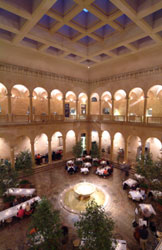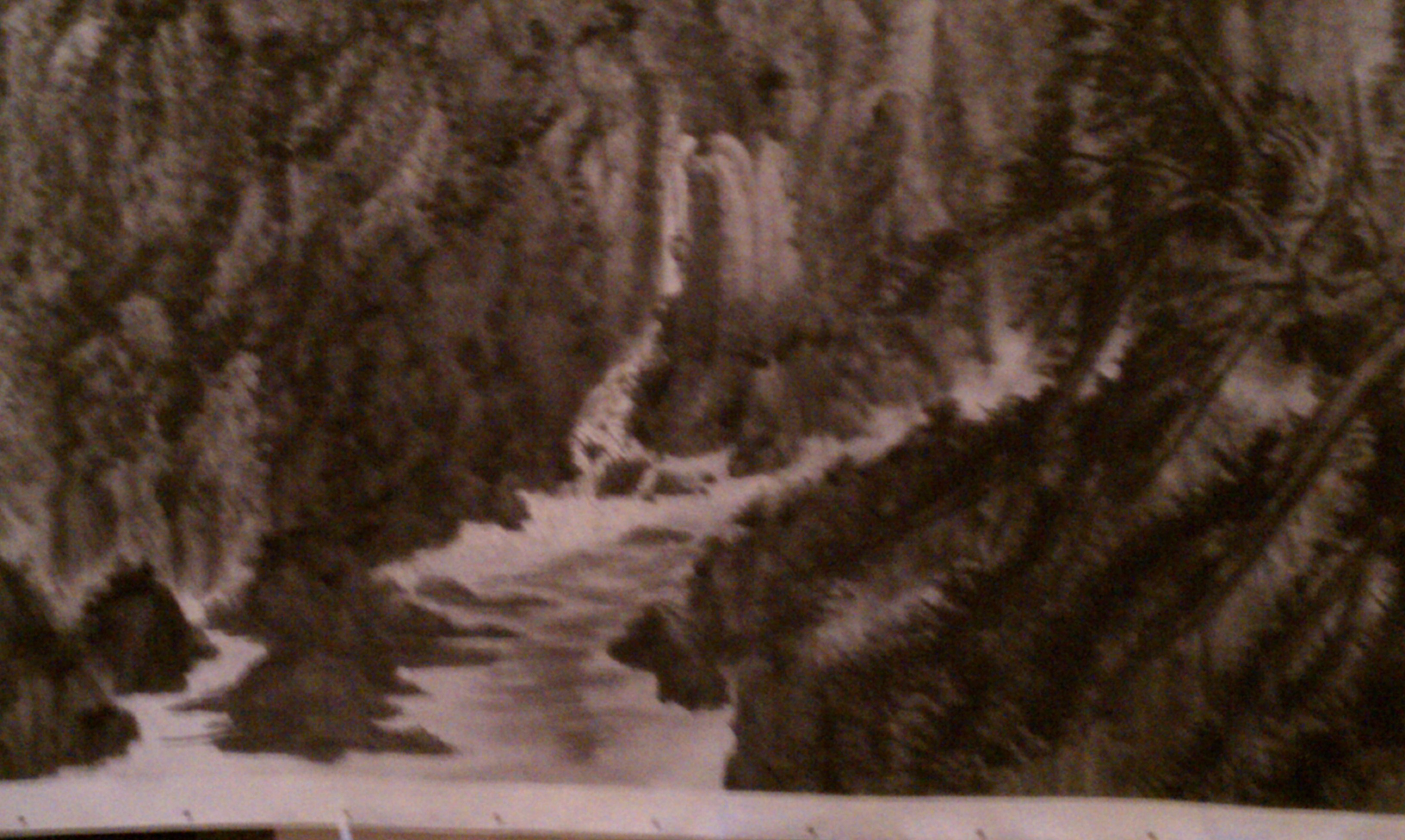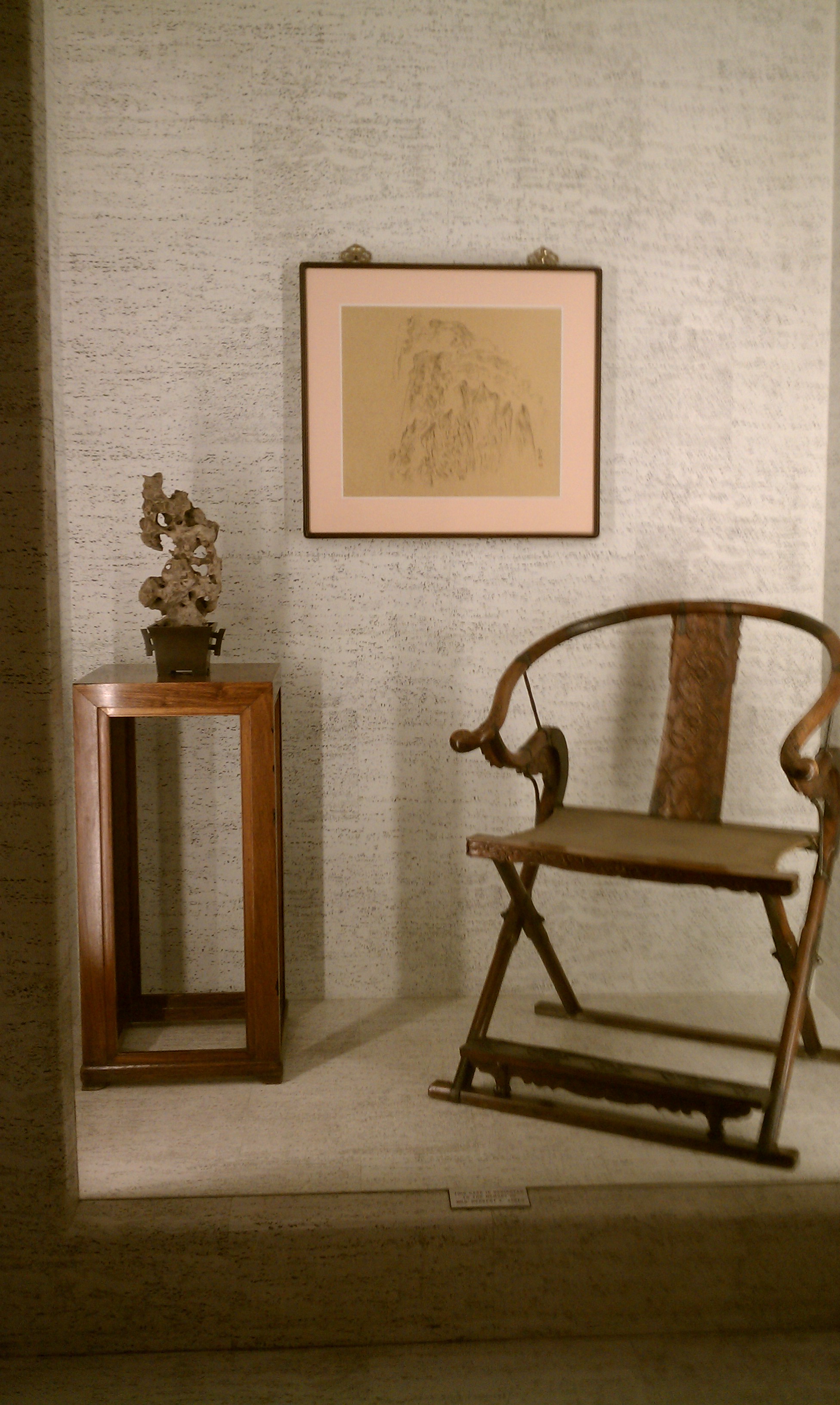
One of my favorite oases in Kansas City is the Nelson-Atkins Museum of Art. I go there when I have a spare hour or two. Last week I went to the Nelson’s special exhibit entitled “Journey through Mountains and Rivers: Chinese Landscapes Ancient and Modern,” and came away with a new appreciation for Chinese art, both old and new.
First came lunch in Rozzelle Court. I indulged in a sandwich and chocolate cookie while sitting in the Italian courtyard. I listened to the music of the babbling fountain and smiled at the frescoed ceilings over balcony galleries.
Once I had provided myself with sufficient sustenance, I headed for Kirkwood Hall, where the Chinese Landscape exhibit began with a huge painting by Xu Longsen, The Law of the Dao Is Its Being What It Is. The painting filled the hall and is too large to be captured adequately in a photograph.
A display board near the painting quotes the artist, Xu Longsen, as saying,
Chinese landscape painting is not the art of imitating the physical appearance of nature. It is a search for a spiritual order through the continuous process of examining configurations of mountains and water. As for myself, whenever I complete a landscape painting, it is like a reordering of my spiritual state.
We all seek spiritual order in art. Art comes in many forms – works and pictures and performance. All art forms help us examine and make sense of the world around us.

What impressed me most about The Law of the Dao was its ambiguities – Were those mountains or clouds? Stones or waterfalls? Water or snow? Was that a face in the tree branches? Each time I glanced at the painting, I saw another perspective, perhaps the result of the artist’s continuous contemplation of mountains and water.
I overwhelmed my senses with the scope of Xu Longsen’s painting – the “modern” part of the exhibit – and compared his work with the ancient scroll located next to it. Then the exhibit directed me upstairs to the Chinese art galleries in the Nelson’s permanent collection. There I spent time focusing on the details of more ancient scrolls in ways I never had before, and listened to a film on the art of Chinese landscapes.
One display in the gallery quoted Confucious:
The wise men find pleasure in waters, the virtuous find pleasure in mountains.
I chuckled. I prefer oceans and lakes over mountains (see here and here); does this make me wise, but not virtuous? Which is better, wisdom or virtue? Does not wisdom compel the wise to behave virtuously? Do not the virtuous possess inner wisdom? Perhaps Confucious, in the spirit of the Dao, meant there is value in all of nature, whatever aspect speaks to our hearts and souls.

One theme throughout the Chinese Landscape exhibit was the universality of ancient and modern art. The path of the exhibit took me to a room pairing 16th and 17th century Chinese furniture from the Nelson’s permanent collection with more of Xu Longsen’s modern paintings. Ancient and modern; it was hard to tell which was which, and both old and new spoke to my spirit.
This room also displayed a number of scholar stones. I may have seen scholar stones before, but I had never focused on them. Chinese scholars prize these oddly shaped rocks for qualities such as openness and asymmetry that make them resemble a landscape or figure. Perhaps they serve as inspiration for poets and painters. I would like to have a scholar stone for my desk. It might remind me to seek spiritual order in what I write.
The Chinese Landscape exhibit remains at the Nelson through April 28. Try to see it – it is well worth an hour or so of your time! (And have a cookie in Rozzelle Court as your reward.)




Thank you Theresa, this outing is scheduled and now I look forward to it even more.
We frequent the gallery often. It is another speaking shadow to my past.
And don’t forget your cookie! Thanks for the comment.
Theresa
I was taken to the gallery at about age nine. Shortly thereafter my family moved back to Southern California (felt like I was going into exile, away from my beloved grandmother). At any mention of China, in classroom or playground, I felt that I had a special understanding, because I had seen a tiny portion of the Great Wall of China. Later I began to privately wonder exactly a part of the Great Wall had gotten from China to Kansas City. One of the first things I did when I returned to Kansas City as an adult was to go re-visit the Great Wall, sadly to learn that what I remembered was only a portion of the wall of a Chinese temple.
Funny story, Peg! Our perspectives do change with the years.
Theresa
Meanwhile, I was at the Morgan Library in NYC yesterday looking at surrealist drawings. My longtime editor Mary displayed her intellectual chops when she said: “You have to go! I never understood surrealism’s impact on Jackson Pollack until I did!” Well, with a recommendation like that, how could I resist? Anyway, the point is that whether it’s Gorky’s or Xu Longsen’s, art is a wonderful refreshment that helps us make sense (or sometimes nonsense) of the world. Thanks for posting.
Art is a refreshment. I hope you understand surrealism better than I do after your time at the Morgan Library.
Thanks, MA.
Theresa
[…] I encourage you to go see it—it is well worth your time. And, of course, you can also partake of the food and atmosphere in Rozelle Court while you’re […]